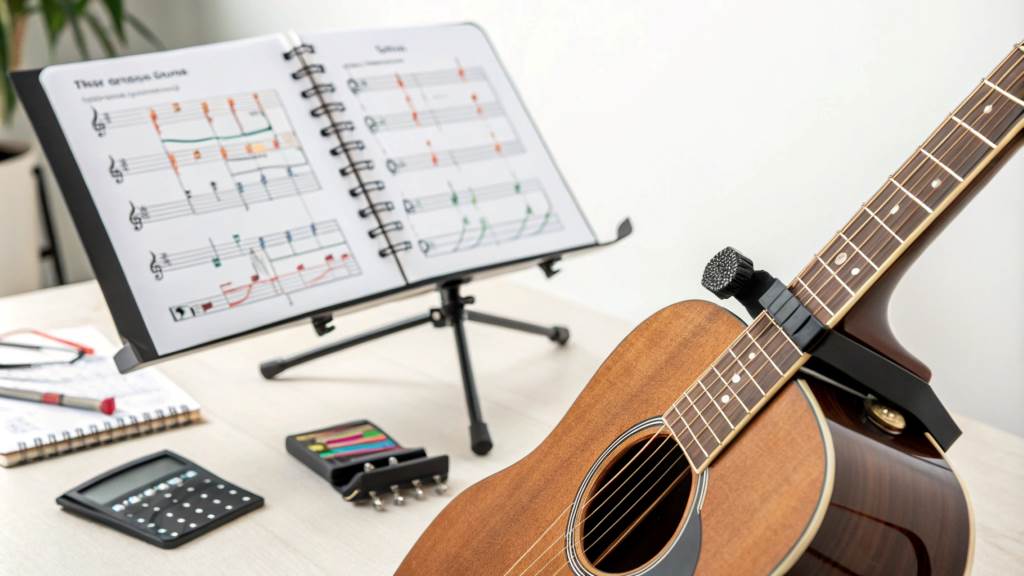Using a capo is like giving your guitar a new voice, unlocking new keys, and transforming your playing experience. For beginners and seasoned players alike, a guitar capo chart is an indispensable tool to understand how this small accessory can make a big difference. From transposing songs to exploring fresh chord voicings, a capo opens up creative possibilities that are otherwise difficult to achieve.
Let’s dive deep into the art of using a guitar capo, how to read a capo chart, and why this knowledge is a must-have for every guitarist.
What Is a Guitar Capo?
A capo, short for “capotasto,” is a clamp-like device that you attach to your guitar’s fretboard. It shortens the playable length of the strings, effectively raising the pitch of the guitar. With a capo, you can transpose a song into a different key without having to learn new chord shapes.
This is particularly helpful when accompanying singers with specific vocal ranges or when you want to simplify tricky barre chords.
Why Use a Guitar Capo Chart?
A guitar capo chart helps you see how chords change when you place a capo on different frets. By using this chart, you can determine which chords to play to match a song’s key.
Here’s why it’s essential:
- Simplifies Transposing: Easily adjust chords to match any key without mental calculations.
- Enhances Creativity: Experiment with new chord voicings.
- Reduces Complexity: Play complex songs with simple open chords.
For example, playing an E major shape with a capo on the third fret produces a G major chord. This chart acts as your cheat sheet for instant transpositions.

How to Read a Guitar Capo Chart
To get the most out of a capo chart, you’ll need to understand a few key points:
- Chord Shapes vs. Chord Names: The chart lists the chord shape you play and its corresponding actual chord. For example, G shape with capo on 2nd fret = A major.
- Capo Positioning: Each fret on the chart represents the capo’s placement.
- Tuning: Ensure your guitar is in standard tuning unless specified otherwise.
Below is an example of how a capo chart looks:
| Capo Fret | Open Chord Shape | Actual Chord Name |
|---|---|---|
| No Capo | G | G |
| 1st Fret | G | G# |
| 2nd Fret | G | A |
| 3rd Fret | G | A# |
Top Benefits of Using a Capo for Guitarists
Using a capo opens the doors to endless possibilities. Here are some reasons why every guitarist should learn to master it:
- Easier Chord Transitions: Some songs feature chords like F#m or B7, which are tough for beginners. A capo lets you simplify them into familiar shapes.
- Better for Vocal Accompaniment: Adjust the song’s key to fit any singer’s vocal range without rewriting the chords.
- Rich Tonal Variety: A capo creates a brighter tone when played higher up the neck.
Popular Capo Techniques Every Guitarist Should Know
The “Key Adjustment” Trick
One of the most popular uses of the capo is key transposition. For example, if a song is in C# major, you can place the capo on the first fret and play chords as if they’re in C major.
Exploring Open Chord Voicings
Instead of limiting yourself to standard chord shapes, try experimenting with open tunings and capos to produce unique voicings. A common example is using the G shape with a capo on the 5th fret to create a C chord.
Guitar Capo Chart for Beginners
Below is a simplified capo chart to help beginners quickly get started:
| Capo Position | Open Chord | Resultant Chord |
|---|---|---|
| No Capo | D | D |
| 2nd Fret | D | E |
| 4th Fret | D | F# |
| 7th Fret | D | A |
By practicing this chart, beginners can develop confidence in applying the capo effectively.
Common Challenges With a Guitar Capo and How to Solve Them
Uneven Tuning
Using a capo sometimes pulls strings out of tune. To avoid this, make sure the capo applies even pressure across the strings. High-quality capos with adjustable tension are your best friend here.
Fret Buzz
Fret buzz occurs when the capo doesn’t press the strings hard enough. Reposition the capo closer to the fret for cleaner tones.
Limited Range
While capos make transposing easier, they can’t replace mastering the fretboard. A well-rounded guitarist should aim to balance capo use with learning advanced chords.
Choosing the Best Capo for Your Guitar
Selecting the right capo depends on your guitar type and playing style:
- Trigger Capos: Easy to use and perfect for quick changes during performances.
- Screw Capos: Offer more precise tension adjustment for classical or acoustic guitars.
- Partial Capos: Cover only certain strings, allowing for creative tunings.
Practical Tips for Using a Guitar Capo Effectively
- Positioning: Place the capo directly behind the fret for the best sound.
- Experiment: Use it on different frets to explore tonal variations.
- Maintenance: Clean your capo regularly to avoid dirt buildup that may affect tuning.
Conclusion
A guitar capo chart is an essential resource for any guitarist looking to explore new musical horizons. Whether you’re simplifying chords, transposing keys, or unlocking fresh tonal possibilities, mastering the use of a capo and its corresponding chart is a skill that pays dividends. With practice, the capo will become a trusted companion in your guitar journey.











+ There are no comments
Add yours